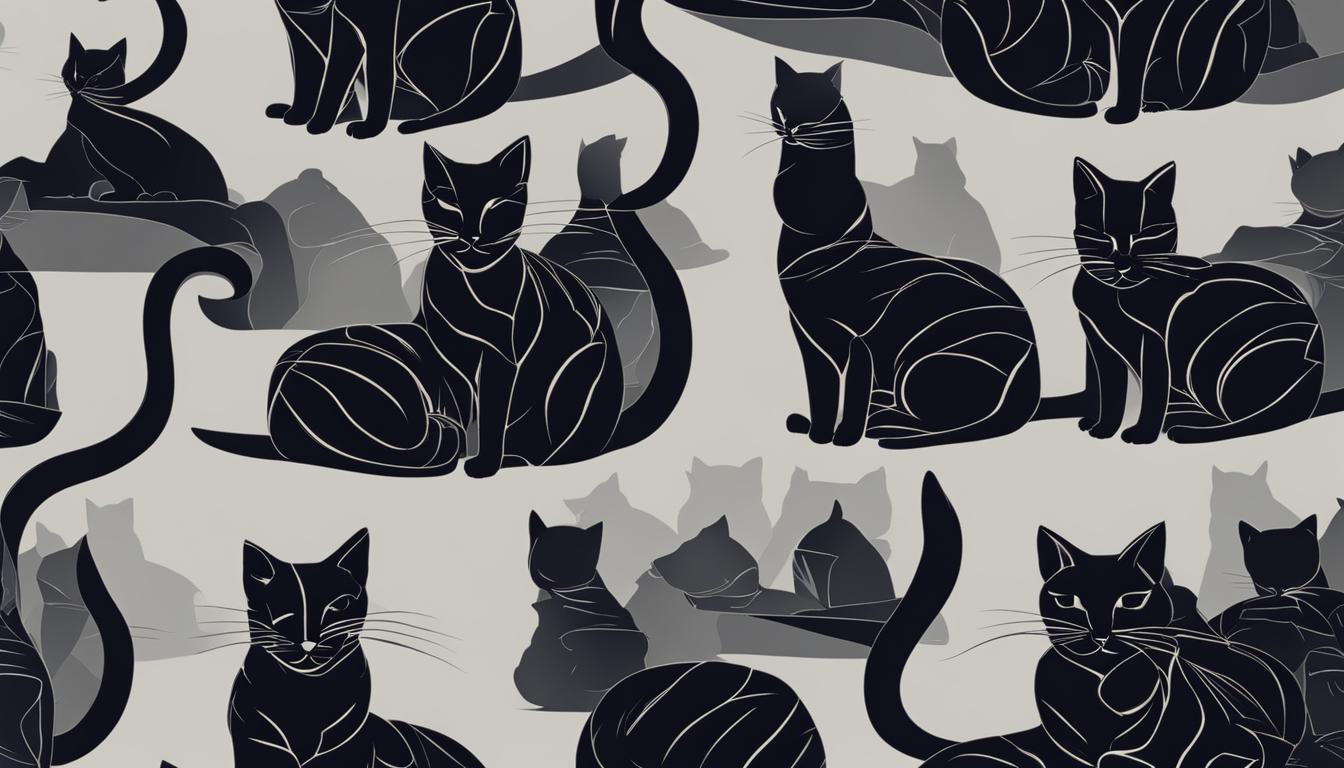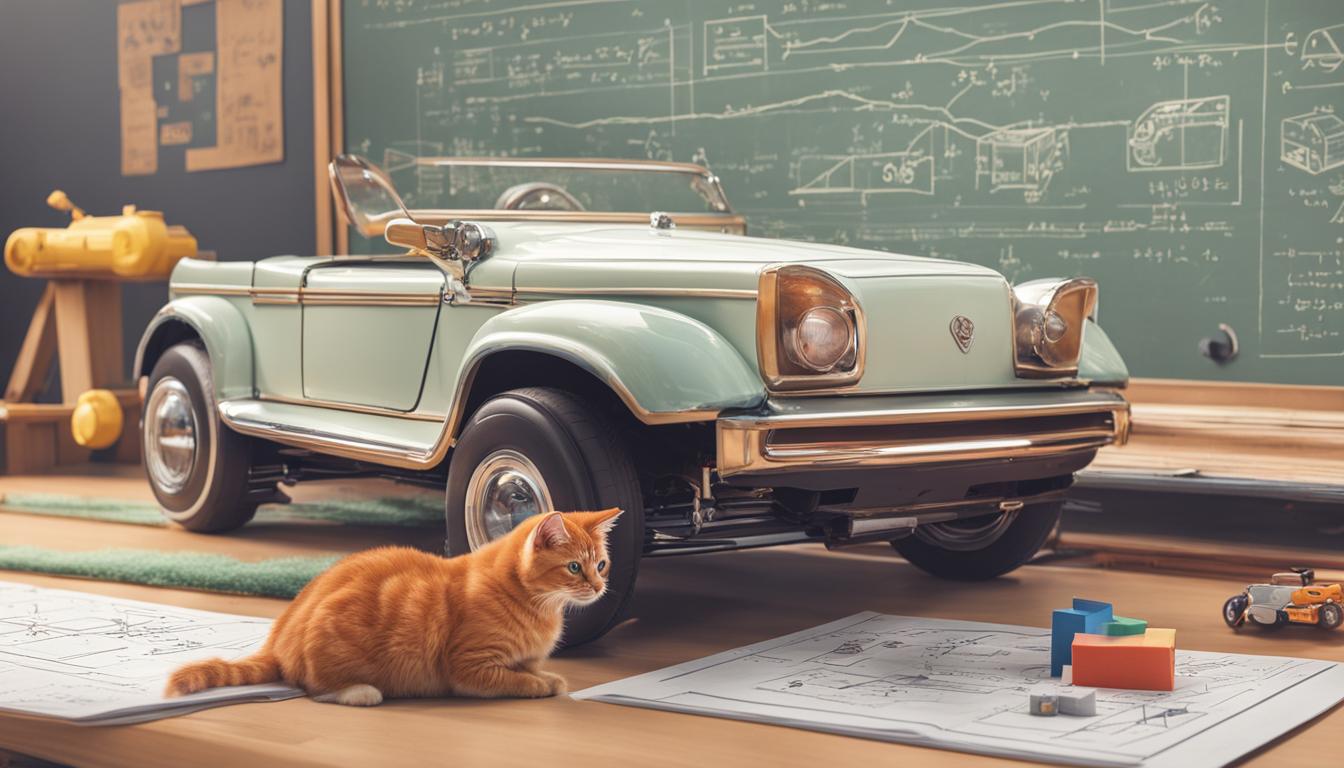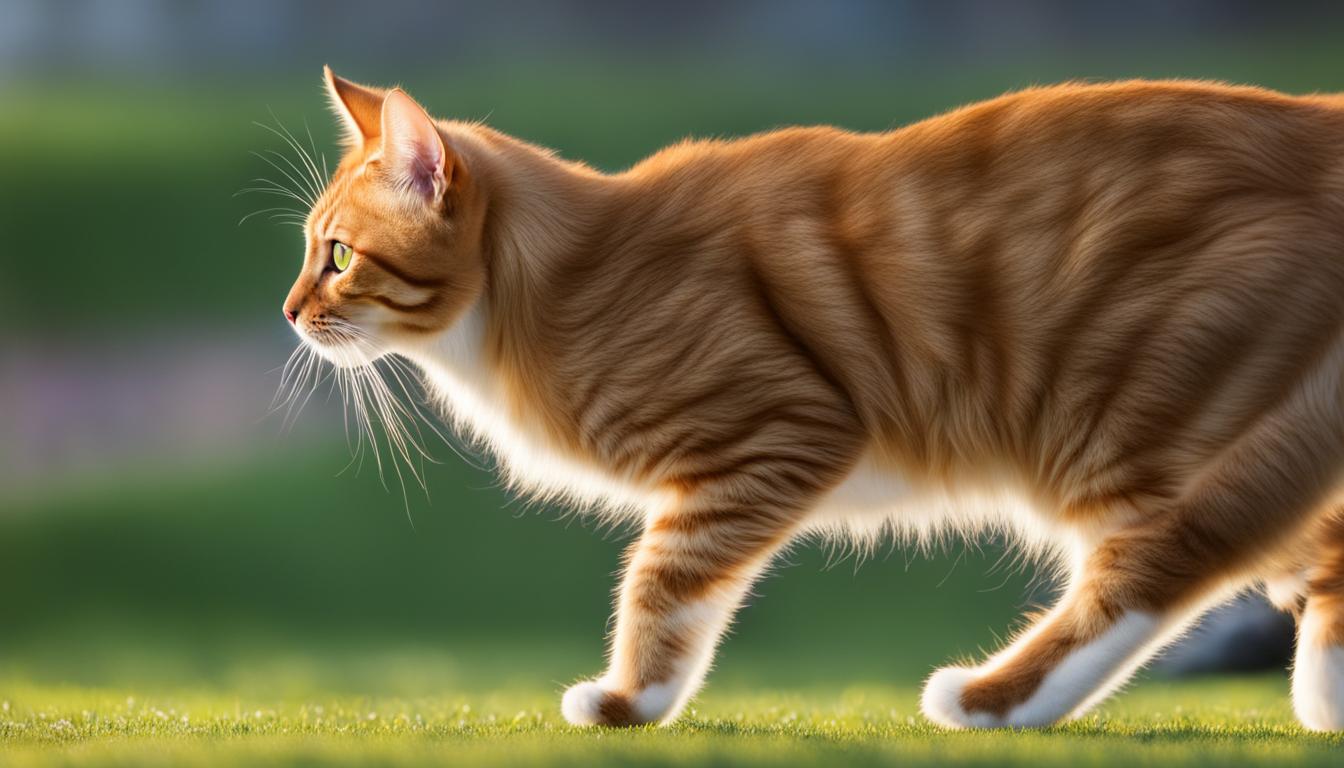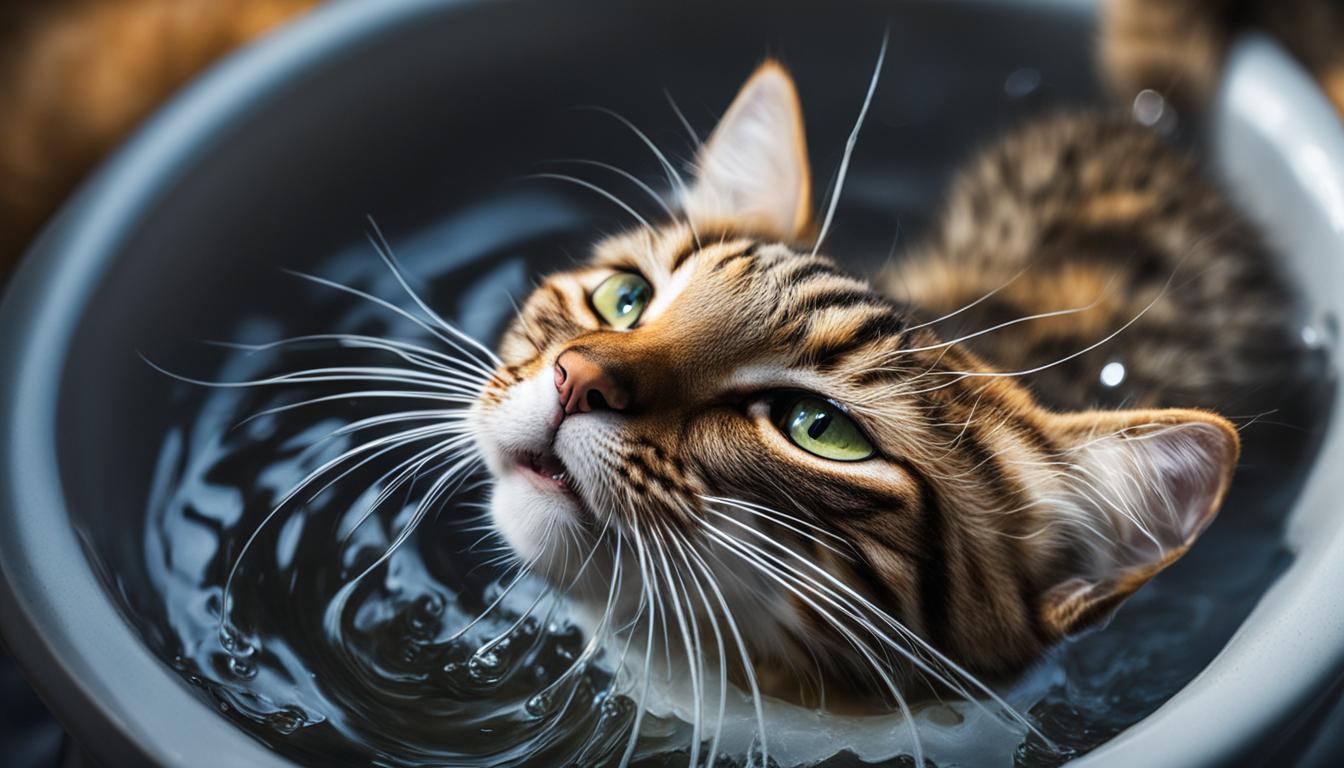Have you ever wondered how your cat manages to move so quietly while stalking its prey? It turns out that cats have a unique way of conserving energy during their hunting pursuits. Unlike other animals, cats prioritize stealth over energetic efficiency, employing a slow and deliberate walking style with their center of mass close to the ground. This crouched posture and unique footfall pattern are essential for reducing mechanical energy recovery, revealing the intricate balance of factors that influence a cat’s locomotor choices.
Key Takeaways:
- Cats use a stealthy walking style to conserve energy during stalking.
- Their crouched posture and unique footfall pattern contribute to reduced mechanical energy recovery.
- This gait is the result of millions of years of evolution in cat species.
- Stealth plays a crucial role in cat stalking, both for domestic cats and their larger wild counterparts.
- Factors such as age, hunting territory, and prey availability can affect a cat’s stalking ability.
The Evolution of Cat Stalking
When it comes to stalking their prey, cats have evolved an intricate and highly effective approach that showcases millions of years of adaptation. The anatomy of a stalking cat is specifically designed to maximize stealth and minimize the chances of detection. Cats walk with their limbs more flexed than distance specialists, allowing for slow, deliberate movements close to the ground. This crouched posture and unique footfall pattern contribute to their ability to silently approach their prey.
The evolution of cat stalking is a testament to the complexity of nature’s design. Over time, cats have developed a stalking posture that enables them to creep up on their prey undetected. This involves a combination of behavioral and anatomical adaptations that work together to ensure a successful stealthy approach. By adopting a gait that is less mechanically efficient but incredibly quiet, cats have honed their ability to surprise and capture their prey.
To understand the evolution of cat stalking, we must consider the interplay between anatomy and behavior. Cats have undergone selective pressures that favor the development of specific traits, such as a more flexed limb posture and a deliberate footfall pattern. These adaptations allow them to navigate their surroundings with precision and move silently through their environment. The evolution of cat stalking provides a fascinating glimpse into the intricate strategies animals employ to ensure their survival.
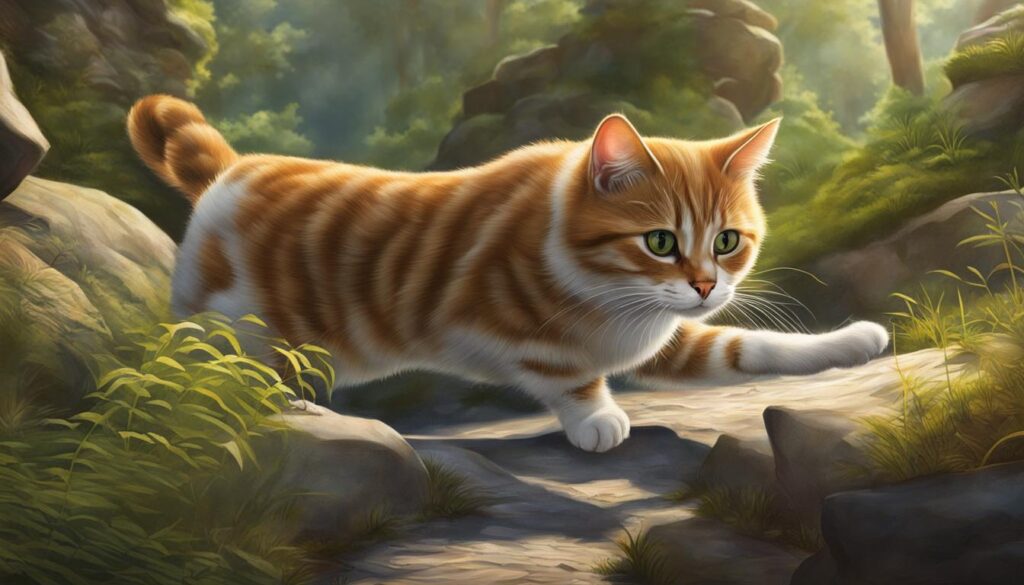
Anatomy of a Stalking Cat
To better understand the anatomy of a stalking cat, let’s examine the key features that contribute to their stealthy approach:
| Feature | Description |
|---|---|
| Crouched Posture | A low, crouched posture allows cats to reduce their profile, making them less visible to their prey. |
| Flexed Limbs | The limbs of a stalking cat are more flexed, resulting in slow, deliberate movements that minimize noise and maximize precision. |
| Quiet Footfall Pattern | Cats employ a unique footfall pattern that ensures minimal noise. They place their hind feet in the same spot as their forefeet, reducing the chances of detection. |
“The evolution of cat stalking highlights the incredible adaptations that have allowed these feline predators to become masters of stealth. Their unique anatomy and behavior work in harmony to ensure successful hunts.”
By understanding the evolution and anatomy of cat stalking, we can gain a deeper appreciation for the incredible abilities that cats possess. The stealthy approach they have developed over time is a testament to their predatory prowess and the intricate balance between survival and energy conservation.
The Science Behind Feline Energy Conservation
Feline energy conservation during a cat’s predatory stalk involves a complex interplay of factors that contribute to their stealthy approach. Cats have evolved specific mechanisms to reduce energy expenditure during stalking, allowing them to move silently and efficiently. Let’s explore the science behind feline energy conservation and the factors that influence a cat’s stalk.
Limb Compression and Footfall Pattern
One of the key factors affecting a cat’s stalk is limb compression during movements. Cats have a unique footfall pattern that helps reduce the sound produced while walking. By landing on their toes and using their long, flexible limbs, cats minimize noise and vibration, allowing for a stealthier approach. This footfall pattern also helps distribute forces more evenly, enabling them to move smoothly and conserve energy.
Pendular Mechanical Energy-Saving Mechanism
Compared to distance specialists, cats have a less effective pendular mechanical energy-saving mechanism. This mechanism involves the transfer of potential energy to kinetic energy, resulting in efficient locomotion. While cats may not have the same energy recovery as other animals during stalking, their ability to maintain a low profile and move with precision compensates for this disadvantage.
| Factors Affecting Feline Energy Conservation | Influence on a Cat’s Stalk |
|---|---|
| Body Size | Smaller cats have an advantage in terms of energy conservation due to their lower mass and agility. |
| Prey Type | The size and behavior of the prey can impact a cat’s stalking strategy and energy expenditure. |
| Environmental Conditions | Factors such as terrain, vegetation, and ambient noise levels can affect a cat’s ability to stalk efficiently. |
Understanding the science behind feline energy conservation provides insights into the intricate adaptations and behaviors of stalking cats. By controlling muscular effort, optimizing limb compression, and utilizing specific footfall patterns, cats have honed their predatory skills over millions of years of evolution. The next section will explore the role of stealth in cat stalking and how it contributes to their hunting success.
The Role of Stealth in Cat Stalking
Stealth is a critical component of cat stalking, whether it’s the big cats in the wild or our domestic feline companions. Cats rely on their camouflage and silent movements to approach their prey undetected. Despite the difference in scale, the principles of stealthy stalking remain the same.
Just like their larger counterparts, domestic cats utilize a low profile and slow, deliberate movements to get close to their target. Their ability to blend into the environment and move silently allows them to surprise their prey, giving them a higher chance of a successful hunt.
Stealth is the ultimate weapon in a cat’s stalking arsenal. The combination of their physical adaptations and behavioral strategies enables them to become masters of concealment and surprise.
Whether it’s a lion in the savanna or a tabby cat in our homes, stealth is a key element in the art of stalking. It showcases the remarkable adaptability and hunting prowess of these feline predators.
Stalking in Big Cats vs Domestic Cats
While the stalking behavior of big cats and domestic cats share similarities, there are also notable differences. Big cats, such as lions and tigers, rely on their size and strength during the hunt, often utilizing short bursts of speed to catch their prey. Domestic cats, on the other hand, focus on stealth and surprise rather than raw power.
This divergence in hunting techniques is influenced by the different environments and prey available to these cats. Big cats typically have larger territories and need to cover significant distances, while domestic cats are more adapted to hunting in confined spaces, such as homes and gardens.
Despite these variations, one thing remains clear: the role of stealth is essential to both big cats and domestic cats when it comes to stalking and capturing prey.
| Big Cats | Domestic Cats | |
|---|---|---|
| Size | Larger | Smaller |
| Hunting Strategy | Short bursts of speed | Stealth and surprise |
| Territory | Large | Smaller, confined spaces |
| Prey | Larger animals | Smaller animals and rodents |
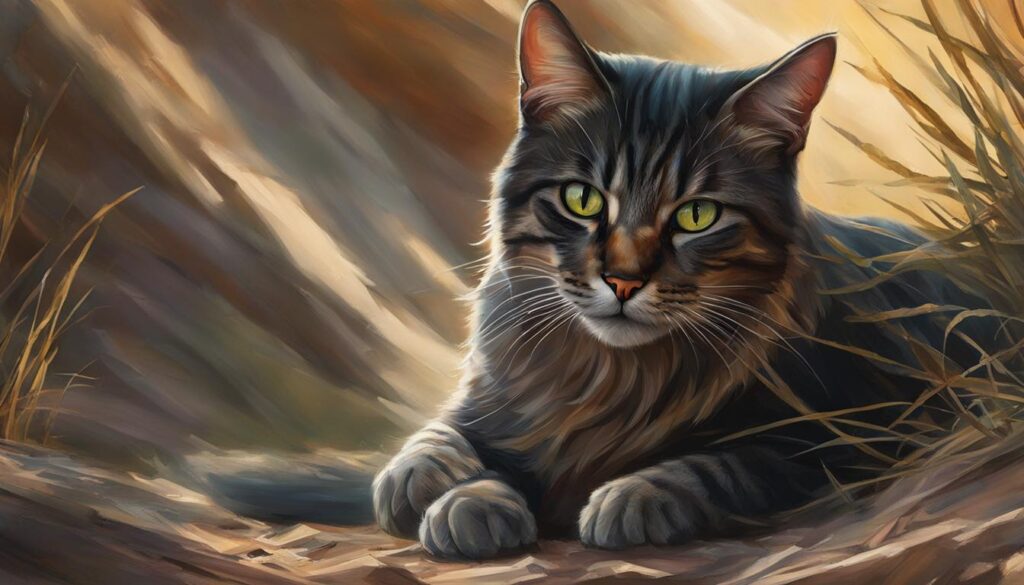
As shown in the table above, big cats and domestic cats have distinctive characteristics that reflect their hunting strategies. The table provides a visual representation of the contrasts between these two groups of feline predators, emphasizing the impact of size, hunting strategy, territory, and prey on their stalking techniques.
Factors Affecting a Cat’s Stalk
Several factors can influence a cat’s stalking ability. One such factor is age. Young kittens begin exhibiting predatory behavior around six weeks old and start practicing hunting techniques. Nursing mothers are the most skilled hunters, while older cats may experience a decline in their stalking prowess due to age-related changes in their physical capabilities.
Another factor that can affect a cat’s stalk is their hunting territory. Cats that have access to larger hunting territories may have more opportunities to develop and refine their stalking skills compared to cats confined to smaller spaces.
Additionally, prey availability plays a significant role in a cat’s stalking success. If prey is scarce in a cat’s environment, they may need to adjust their stalking strategies or target different types of prey. Finally, individual hunting skills can vary among cats. Some cats may be more naturally adept at stalking and capturing prey, while others may require more practice or guidance from their owners to develop these skills.
How Age Affects Cat Stalking
Age is a crucial factor in a cat’s stalking ability. As kittens, cats learn and practice their hunting techniques, honing their stalking skills over time. Nursing mothers are particularly skilled hunters as they need to provide food for their young. However, as cats age, they may experience physical changes that can affect their stalking prowess.
Older cats may have reduced agility, flexibility, or strength, making it more challenging for them to perform the crouched postures and slow movements associated with stalking. Age-related changes can also impact a cat’s stamina, limiting their ability to sustain a prolonged stalking approach. However, it’s important to note that not all older cats will experience a decline in their stalking ability, as individual factors such as overall health and lifestyle can also play a role.
| Factors Affecting a Cat’s Stalk | How Age Affects Cat Stalking |
|---|---|
| Age | Older cats may experience physical changes that can impact their stalking ability, such as reduced agility and stamina. |
| Hunting Territory | Cats with access to larger hunting territories may have more opportunities to develop their stalking skills. |
| Prey Availability | The abundance or scarcity of prey in a cat’s environment can influence their stalking success. |
| Individual Hunting Skills | Some cats may be naturally more skilled at stalking and capturing prey compared to others. |
Understanding the factors that affect a cat’s stalk can help pet owners create an environment that supports their feline companion’s predatory instincts. Providing opportunities for play, mental stimulation, and access to hunting territory can help cats maintain and improve their stalking skills throughout their lives.
Techniques to Improve Stalking in Cats
Environmental Enrichment
One technique to improve stalking skills in cats is through environmental enrichment. By providing interactive toys and hiding spots, you can simulate hunting scenarios and encourage natural stalking behavior. Cats are instinctive hunters, and these enrichment activities can help them channel their predatory instincts in a safe and engaging way. Interactive toys that simulate prey movements, such as feather wands or laser pointers, can be especially effective in honing a cat’s stalking abilities.
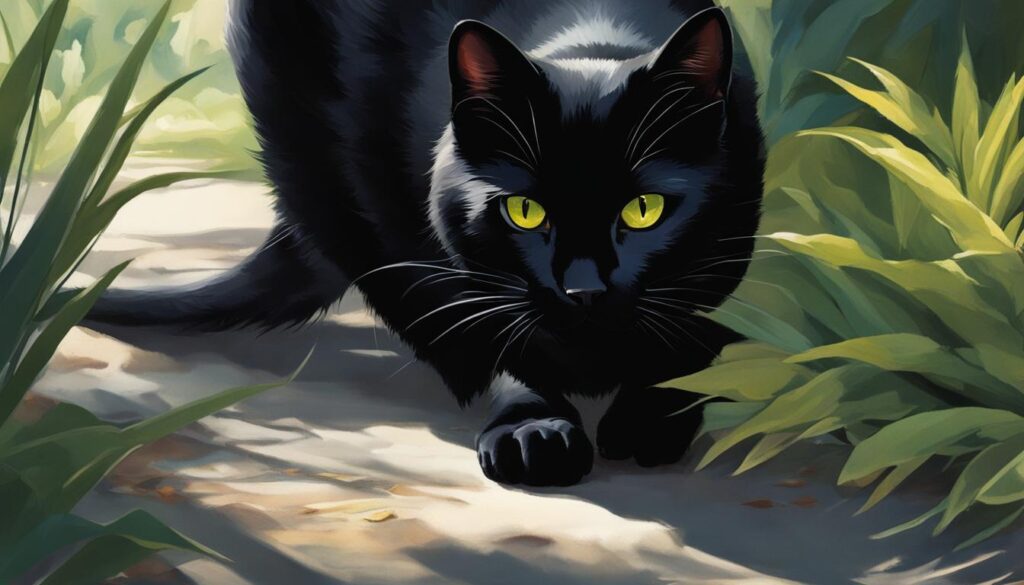
Playful Prey Games
In addition to environmental enrichment, playing games that mimic prey movements can also enhance a cat’s stalking skills. This can include using toys that resemble small animals or insects and moving them in a way that imitates natural prey behavior. By engaging in these play sessions, cats can practice their stalking techniques, improve their agility, and enhance their hand-eye coordination. It’s important to note that these play sessions should always be supervised to ensure the cat’s safety and to prevent the toy from becoming a choking hazard.
Healthy Weight and Balanced Diet
Another crucial aspect of improving a cat’s stalking abilities is maintaining a healthy weight and providing a balanced diet. Excess weight can hinder a cat’s agility and overall physical performance. By ensuring that your cat is at a healthy weight, you can enhance their ability to move swiftly and silently during the stalking process. Additionally, a balanced diet that meets all of their nutritional needs will provide the necessary energy for successful hunting and stalking behavior. Consult with a veterinarian to determine the appropriate diet and portion sizes for your cat.
| Technique | Description |
|---|---|
| Environmental Enrichment | Providing interactive toys and hiding spots to simulate hunting scenarios |
| Playful Prey Games | Using toys that mimic prey movements to enhance stalking skills |
| Healthy Weight and Balanced Diet | Maintaining a healthy weight and providing a balanced diet for agility and energy |
Comparing Cat Stalking to Other Animals
When it comes to stalking, cats have a unique approach that sets them apart from other animals. While dogs prioritize energy efficiency and use a four-footed running style for long-distance pursuits, cats have evolved a profoundly inefficient gait that allows them to creep up on prey in slow motion. This distinct hunting strategy showcases the diversity of evolution and the different techniques animals employ to catch their prey.
Unlike cats, dogs rely on speed and endurance during a chase, using their four legs to cover long distances quickly. This efficient running style allows them to conserve energy while pursuing their quarry. In contrast, cats have developed a stealthy walking style that demands slow movements performed with the center of mass close to the ground. This crouched posture, combined with a unique footfall pattern, is associated with reduced mechanical energy recovery, highlighting the complex and conflicting pressures that govern a cat’s locomotor choices.
Cat stalking behavior also differs from other animals in terms of hunting techniques. Cats, whether domestic or wild, rely on their stealth and camouflage to approach their prey undetected. They utilize a low profile and slow, deliberate movements to get close to their target. This stalking behavior is comparable to that of big cats in the wild, further emphasizing the effectiveness and universality of this strategy across various feline species. Through millions of years of evolution, cats have perfected their ability to silently and efficiently approach prey, showcasing their exceptional predatory skills.
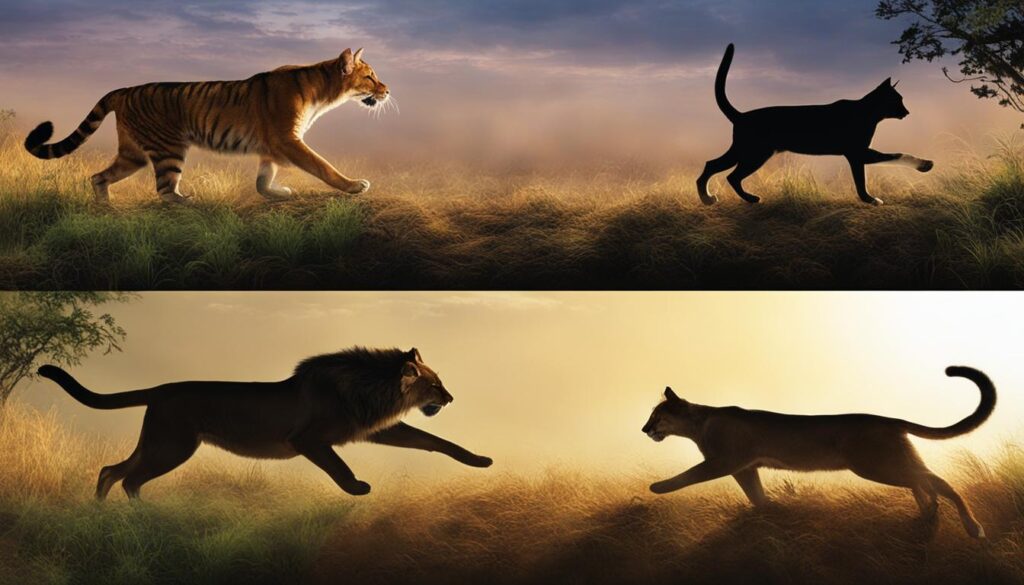
Conclusion
After delving into the world of cat stalking, it’s clear that energy conservation is at the heart of this extraordinary behavior. Cats have honed their predatory skills through millions of years of evolution, developing a unique and stealthy approach to hunting.
The science behind feline energy conservation in a cat’s predatory stalk is fascinating. By controlling muscular effort and adopting specific postures and footfall patterns, cats reduce their energy expenditure while maintaining their silent and efficient movements.
While cats may not prioritize energetic efficiency like other animals, their ability to approach prey undetected is a testament to their exceptional predatory skills. Understanding the science behind cat stalking can help us appreciate the complexity and grace of our feline companions’ hunting instincts.
FAQ
How do cats conserve energy while stalking?
Cats conserve energy while stalking by using a stealthy walking style that demands slow movements performed with the center of mass close to the ground. This crouched posture and unique footfall pattern are associated with reduced mechanical energy recovery.
Why do cats have an inefficient gait during stalking?
The inefficient gait adopted by cats during stalking is the result of millions of years of evolution. Cats have evolved a stalking posture that allows them to creep up on their prey without being detected. This involves walking with their limbs more flexed than distance specialists and using a series of slow, deliberate movements close to the ground.
What factors contribute to a cat’s energy conservation during stalking?
Cats reduce their energy expenditure during stalking by controlling muscular effort and adopting specific postures and footfall patterns. Factors such as limb compression, footfall pattern, and the phase relationship between potential and kinetic energy influence the degree of energy recovery during stalking.
What role does stealth play in cat stalking?
Stealth plays a crucial role in cat stalking. Domestic cats, like their larger counterparts in the wild, rely on camouflage and silent movements to approach their prey undetected. The stalking behavior of cats is comparable to that of big cats, with both relying on a low profile and slow, deliberate movements to get close to their target.
What factors can affect a cat’s stalking ability?
Several factors can influence a cat’s stalking ability. Age is one factor, with young kittens beginning to exhibit predatory behavior around six weeks old. Other factors include hunting territory, prey availability, and individual hunting skills. Older cats may experience a decline in stalking prowess due to age-related changes in physical capabilities.
How can cat stalking skills be improved?
Techniques such as providing environmental enrichment, interactive toys, and hiding spots can simulate hunting scenarios and encourage natural stalking behavior. Playing games that mimic prey movements can also enhance a cat’s stalking abilities. Additionally, maintaining a healthy weight and providing a balanced diet can ensure that cats have the physical energy and agility required for successful stalking.
How does cat stalking differ from other animals?
Cat stalking behavior differs from other animals in terms of energy conservation and hunting techniques. While dogs prioritize energy efficiency and use a four-footed running style for long-distance pursuits, cats have evolved a profoundly inefficient gait that allows them to creep up on prey in slow motion. This distinct approach to hunting showcases the diversity of evolution and the different strategies animals employ to catch their prey.
What have we learned about feline energy conservation in cat stalking?
The study of feline energy conservation in cat stalking sheds light on the unique adaptations and behaviors of feline hunters. Through millions of years of evolution, cats have developed a stealthy walking style, crouched postures, and specific footfall patterns that contribute to reduced mechanical energy recovery during stalking. While cats may not prioritize energetic efficiency like other animals, their ability to approach prey undetected is a testament to their exceptional predatory skills.

